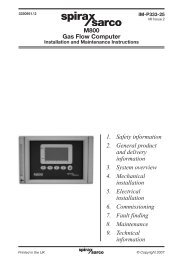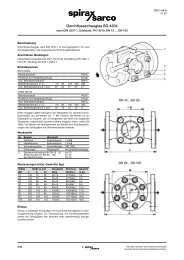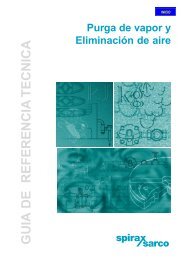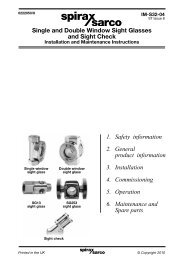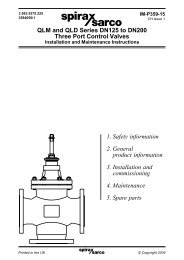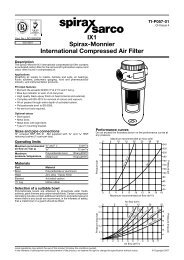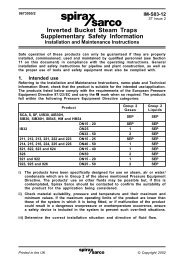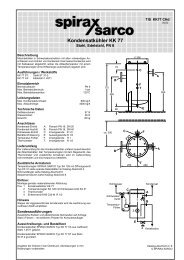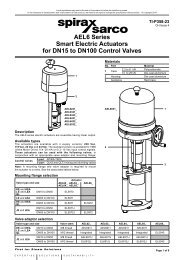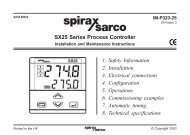2000 Hook-up Book - Spirax Sarco
2000 Hook-up Book - Spirax Sarco
2000 Hook-up Book - Spirax Sarco
You also want an ePaper? Increase the reach of your titles
YUMPU automatically turns print PDFs into web optimized ePapers that Google loves.
SYSTEM DESIGN<br />
30<br />
Temperature Control Valves for Liquid Service<br />
Mixing And Diverting<br />
Three-Port Valves<br />
A three-port temperature control<br />
has one port that is constantly<br />
open and it is important that the<br />
circulating pump is always positioned<br />
on this side of the system.<br />
This will prevent the risk of pumping<br />
against dead end conditions<br />
and allow correct circulation to do<br />
its job.<br />
The valve can be used either<br />
to mix or divert depending <strong>up</strong>on<br />
how it is piped into the system. A<br />
mixing valve has two inlets and<br />
one outlet, a diverting valve has<br />
one inlet and two outlets.<br />
Fig. 43 illustrates the threeport<br />
valve used as a mixing valve<br />
in a closed circuit. It has two inlets<br />
(X and Z) and one outlet (O) which<br />
is the permanently open port. Port<br />
X is the port open on start<strong>up</strong> from<br />
cold, while Port Z will normally be<br />
closed on start<strong>up</strong> from cold. The<br />
amounts of opening in Ports X and<br />
Z will be varied to maintain a constant<br />
outlet temperature from Port<br />
O. Thus a certain percentage of<br />
hot boiler flow water will enter<br />
through Port X to mix with a corresponding<br />
percentage of cooler<br />
return water via Port Z.<br />
When the three-port valve is<br />
used to blend cold s<strong>up</strong>ply water<br />
with hot water which may be from<br />
Hydrogen gas is an important ingredient to many oil refining<br />
processes. Large multi-stage compressors are located<br />
in operating sections throughout the refinery. Considerable<br />
attention is paid to maintaining gas quality, and keeping<br />
liquid from accumulating in the system.<br />
The telltale signs of entrained liquid became evident<br />
as a high-pitched whistling noise was heard coming from<br />
the compressor sections. It was determined to be the<br />
result of poor cooling water temperature control. The cooling<br />
water/Glycol mixture leaving the heat exchanger at<br />
95°F, circulating through the compressor jacket was causing<br />
excess hydrogen condensing on the cold surfaces of<br />
jacket walls. It’s important to maintain the 95°F heat<br />
exchanger outlet temperature to assure that sufficientlycool<br />
water/Glycol is s<strong>up</strong>plied to the compressor sections<br />
necessary for proper heat transfer.<br />
another source, for use in showers<br />
or similar open circuits where<br />
all the water does not recirculate,<br />
it is essential that the pressure of<br />
the s<strong>up</strong>plies be equal. For these<br />
applications, it is recommended<br />
that both the X and Z ports be fitted<br />
with check valves to prevent<br />
any scalding or other harmful<br />
back-flow condition.<br />
With the valve connected as<br />
shown in Fig. 43A, we now have a<br />
diverting arrangement. The valve<br />
has one inlet and two outlets. Hot<br />
water enters Port O and is either<br />
allowed through Port X to the<br />
equipment or through Port Z to<br />
return to the boiler.<br />
The Need for Balancing<br />
The action of a three-port valve in<br />
a closed circuit system, whether<br />
mixing or diverting, tends to<br />
change the pressure conditions<br />
around the system much less than<br />
does a two-port valve. This stability<br />
is increased greatly when a<br />
balancing valve is fitted in the<br />
bypass (or mixing connection)<br />
line. Not fitting a flow balancing<br />
valve may result in short circuiting<br />
and starvation of other subcircuits.<br />
The balancing valve is set so<br />
that the resistance to flow in the<br />
bypass line equals or exceeds that<br />
in the load part of the subcircuit.<br />
In Fig. 43, the balance valve<br />
must be set so that the resistance<br />
to flow in line B-Z is equal to the<br />
resistance to flow in line B-A-X. In<br />
Fig. 43A, resistance B-Z must<br />
equal resistance X-C-B.<br />
Make<strong>up</strong> Air Heating Coils<br />
Air heating coils in vented condensate<br />
return systems,<br />
especially preheat coils s<strong>up</strong>plied<br />
with low pressure steam modulated<br />
by a control valve, can present<br />
difficulties in achieving satisfactory<br />
drainage of condensate. There<br />
is no problem at full load with<br />
properly designed equipment, but<br />
part load conditions often lead to<br />
flooding of the coils with condensate,<br />
followed by waterhammer,<br />
corrosion and sometimes by<br />
freeze-<strong>up</strong> damage. These problems<br />
are so widespread that it is<br />
worth examining their causes and<br />
remedies in some detail.<br />
Coil Configurations<br />
The coils themselves are usually<br />
built with a steam header and a<br />
condensate header joined by<br />
finned tubes. The headers may be<br />
both at one side of the unit, with<br />
hairpin or U tubes between them,<br />
or sometimes an internal steam<br />
tube is used to carry the steam to<br />
the remote end of an outer finned<br />
tube. Vertical headers may be<br />
used with horizontal finned tubes,<br />
Case in Action: Hydrogen Compressor Cooling Jacket Temperature Control<br />
Solution<br />
A 2" temperature control with adjustable bleed and a sensing<br />
system was installed on the cooling water/Glycol outlet<br />
piping from three stages for each of two compressors.<br />
They were set to maintain a discharge temperature of<br />
140°F. This had the effect of holding back Glycol in the<br />
jacket sufficiently to prevent excess hydrogen condensing<br />
while, at the same time, maintaining necessary cooling.<br />
Benefits<br />
• Reduced energy consumption as hydrogen condensing<br />
is reduced.<br />
• Installation of a self-contained control was far less<br />
expensive than a more sophisticated pneumatic type<br />
that was also under consideration.<br />
• System start-<strong>up</strong> was fast because of the easily-adjusted,<br />
pre-calibrated sensing system.<br />
• Accurate process temperature control of each jacket<br />
resulted from having separate controls on each.



